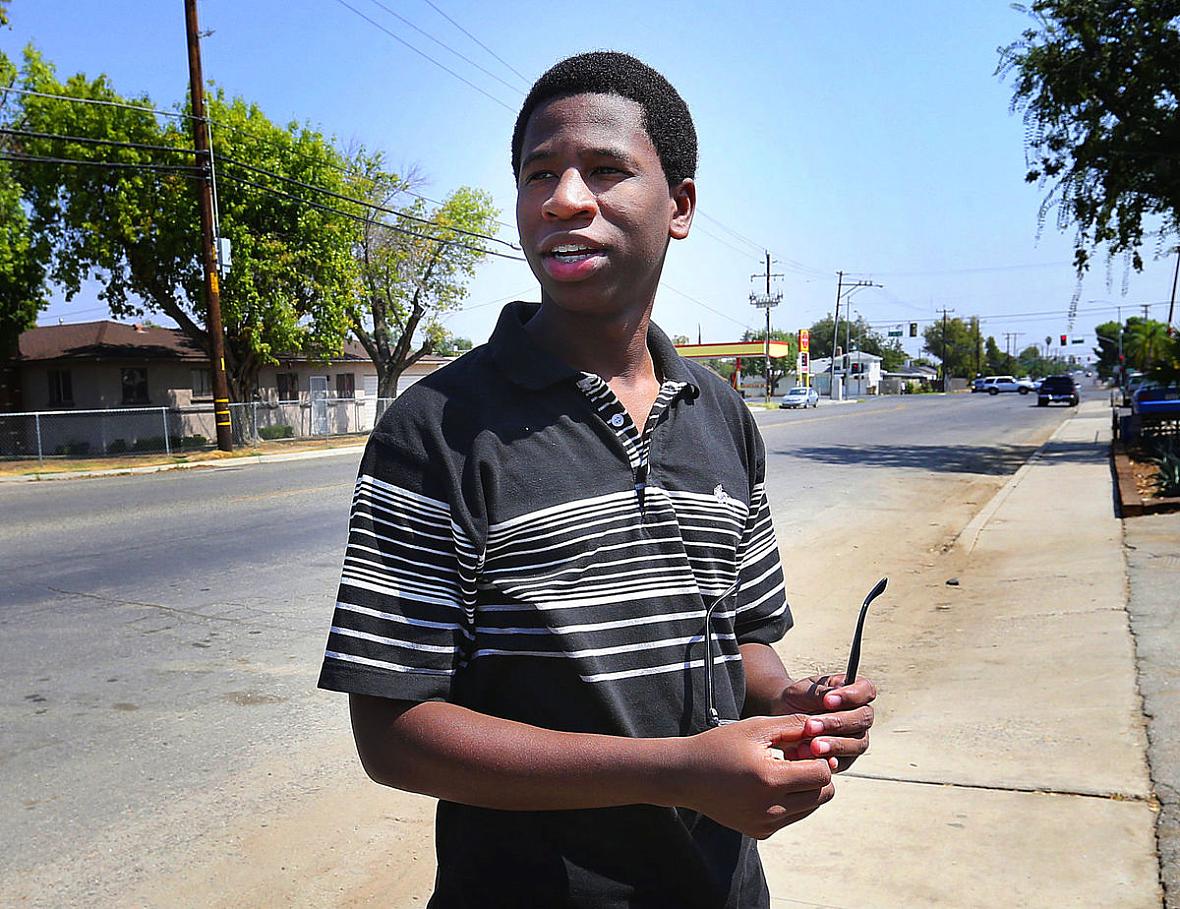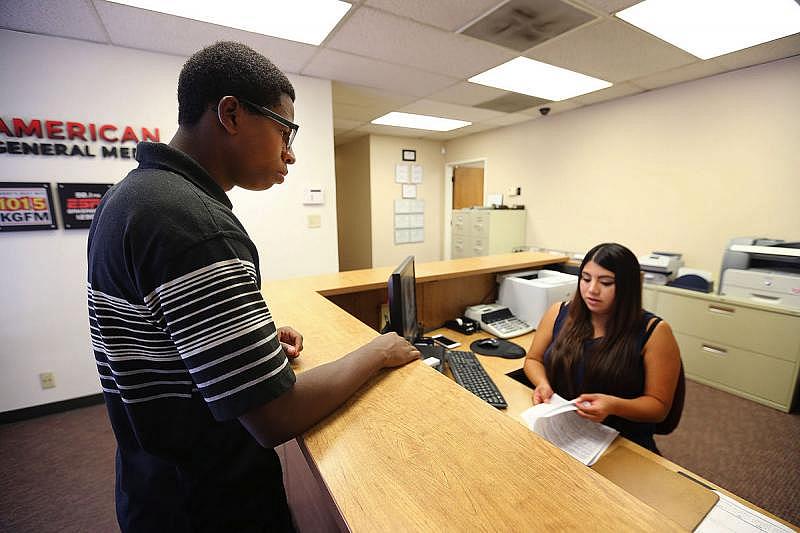Toxic stress is a killer — what can we do about it?
The Californian's Harold Pierce wrote this story while participating in the USC Center for Health Journalism's California Fellowship.
Other stories in the series include:
Christy Luton struggled with childhood trauma; now she helps others face their demons
'An invisible crisis': Toxic stress is helping to shorten life spans in many Kern County communities
A year after the Erskine Fire, kids are still grappling with trauma

Isaiah Mosely came through the foster system. He is a model of resilience and overcoming. Henry A. Barrios/The Californian
Isaiah Mosley’s father was gunned down when he was just 3 years old. Years later, his brother was killed in a high-profile shooting outside a hookah bar in Bakersfield.
In between, his mother was incarcerated and he was shuffled into foster home after foster home. Eventually, he was separated from his sister, the only other person in the world who could understand what he was going through.
Now, when he walks around his neighborhood at night, he gets worried. His heartbeat races. He wonders if he might die the same way his brother and father had.
“There were times I would cry and cry and say that I wanted to die,” said Mosley, now 20, reflecting back on his childhood.
Stress is a powerful force. It can help us survive, but in some cases, lead to a lifetime of medical issues. A kid can only endure so many stressful traumatic experiences before it impacts his health.
Toxic stress, the constant overloading of the body’s stress-response system, leads to serious lifelong repercussions including increased chances of developing cardiovascular and respiratory diseases, among a slew of other health issues. It’s triggered by repeated trauma, like what Mosley endured growing up, dealing with his mother’s incarceration, the deaths of his father and brother, the separation from his sister and uncertainty of where he might end up next.
Most research points to early intervention being key to reducing the likelihood of childhood trauma leaving a lasting impact. As research emerges about the health impacts of childhood trauma, more public agencies are stepping in for people like Mosley before it’s too late.
The California Endowment, a private nonprofit dedicated to improving health care and creating healthy communities, released a report this year calling toxic stress a “hidden health crisis.” It stated that toxic stress is most pervasive in Kern County, killing middle-aged white men at numbers never seen before while setting others on a course of alcoholism, drug abuse, depression and suicide.
The report suggested the economics of the region were among the largest drivers of what California Endowment Senior Vice President Dr. Tony Iton described as “deaths of despair.”
A multifaceted approach would be the only way to solve the problems, Iton said. Medical coverage must be expanded and behavioral health service workers must provide more outreach, legislators have to create policies to reduce income inequality while bolstering impacted economies, and the “social safety net — from food access to high-quality child care — needs to be strengthened,” Iton said.
Two months later, the Sierra Health Foundation held a march on the steps of the state Capitol to urge legislators to enact policies that would stymie poverty and create better health outcomes in the San Joaquin Valley. Sierra Health Foundation’s report, “California’s San Joaquin Valley: A region and its children under stress,” laid bare entrenched social and economical issues that lead to toxic stress in households.
By the spring, nine state and local organizations offered $3 million to 70 nonprofits through the Sierra Health Foundation to create community-based solutions, and develop policy and system changes for improving health outcomes.
The money went to a broad series of efforts ranging from affordable housing and general health access to youth leadership and mental health endeavors.
It’s a turnaround effort in one of the nation’s “most underinvested areas,” according to Chet Hewitt, president and CEO of the Sierra Health Foundation.
By finding solutions to air quality issues, food insecurity, unsafe drinking water and exposure to violence in neighborhoods, the number of traumatic experiences kids are exposed to could be reduced, the report states.
“Repeated exposure to adversities such as these produces toxic levels of stress that can have negative and long-lasting effects on learning, behavior and health,” the report states.
RAISING RESILIENCE
Meanwhile, local schools have placed an increased emphasis on trauma-informed care, partially spurred by new state requirements that tie funding to school climate.
Bakersfield City School District implemented a new social and behavioral learning model this year focusing on the health of the whole child. It spent the first three days of school working on personal relationships and talking in group circles. The goal is that, eventually, students would feel comfortable enough to share personal issues they are working through and teachers could refer them to counselors for early intervention.
Compelled by the settlement terms of a lawsuit alleging discriminatory disciplinary practices against minorities, the Kern High School District has begun training every one of its employees in Positive Behavioral Intervention and Supports, a popular approach to creating supportive environments and cultures in school settings.
Collaborative Learning Solutions, the educational consulting group introducing staff members to the concept, developed a pilot program at North and Golden Valley high schools last year called “Raising Resilience.”
The idea is to take traditional “trouble” students and instead of disciplining them, teach them replacement strategies. So a kid who would traditionally be suspended for defiance would instead take part in mindfulness training, then reflect and review on on the choices they made, said Debbie Sacks, an educational consultant with CLS.
When kids act out, staff members are trained to question what’s at the core of it, instead of just disciplining them for their actions, Sacks said.
“It’s going to shift the way people act toward kids,” Sacks said.
That strategy has led to some breakthroughs, she said.
North and Foothill, she said, had few students who reoffended after going through the training. It also helps them understand what the core of their disciplinary problems are, she said.
“They’re coming to school with a lot of stress — toxic stress — and anxiety,” Sacks said. “They’re witnessing things in their neighborhoods that interrupt the learning process.”
Sacks is hinting at things such as gang violence, domestic violence, alcoholism and drug abuse — all of which cultivates anxiety in a child.
With PBIS, schools are adding social workers and therapists and pushing in more support for the health of the child. They’re also teaching kids breathing techniques and getting them accustomed to doing it everyday.
“They see it as a strategy for survival,” Sacks said.
It’s a strategy the district plans to continue, Sacks said.
‘THIS IS IN OUR DNA’
In Bakersfield, there’s a 2-square-mile neighborhood spanning east from Chester Avenue to Washington Avenue that sees a disproportionate amount of gang violence and other crime. Its residents, overwhelmingly black and Hispanic, are less educated and earn, in some cases, less than half of Bakersfield’s $35,000 median income.
The neighborhood is a short walk from the Section 8 apartments off Belle Terrace that Moseley calls home.
This is where the Bakersfield Police Department has decided to focus its energies combating toxic stress.
The department received a $517,000 “Cops, Clergy and Community” grant from the Board of State and Community Corrections that would train officers in alternative forms of policing and behavioral health, provide peer mentoring, parenting skills, and address toxic stress issues in the community.
Research shows that those who endure a childhood of trauma are more likely to fall into a cycle of alcoholism, injection-drug use, poverty and, in some cases, face the same demon their parents faced. Enough trauma can change somebody’s DNA, researchers say, creating intergenerational toxic stress.
The neighborhood, in fact, suffers from a “multigenerational tradition” of gang infestation, according to BPD’s grant application.
The grant program would use a collaborative approach to provide not only violence intervention, but also peer mentoring and parenting skills services to families and criminal offenders.
“This approach is intended to generate long-term solutions to an issue traditionally handled primarily by law enforcement alone,” the grant states.
The program is, in part, based on work being done in San Joaquin County, which is becoming a model for toxic stress intervention practices. (See the accompanying sidebar.)
THE DREAM CENTER
Isaiah Mosely turns in a job application at American General Media to Sandra Hernandez, a programming assistant at the radio stations. Henry A. Barrios/The Californian
As for Moseley, most days he heads to The Dream Center, a one stop-shop for foster and emancipated youth.
From the center’s 18th Street location, they offer behavioral counseling, food stamps, Medi-Cal assistance, substance abuse and recovery services, bus passes, resume help, hot meals, and other services under one roof. Through it, Moseley found out about housing assistance.
He’s living in an apartment complex for foster youth transitioning into adulthood in central Bakersfield — the very same complex his aunt lived in when she was a foster youth. His rent is covered through Building Blocks, a transitional housing program offered through the Kern County Department of Human Services that provides a home in exchange for volunteer work.
“They have other agencies where they can access all this, but when it’s in one place, they actually use it,” Jayme Stuart, a coordinator with the Kern County Network for Children, which operates The Dream Center.
But most of the time, kids just come in for a free lunch and some conversation with other kids who understand what they’re going through. In many cases, they form close relationships with those who work there, affording them positive adult role models.
Moseley walked in on a recent Thursday, as he does most weekday afternoons, for a hot dog and to joke around with the Network for Children's executive director, Tom Corson, who also doubles as the daily cook.
“You looking for a job today?” Corson asked Moseley, who just came back from filling out an application at a local radio station, a career he said he’s interested in pursuing once he graduates from college. “I just want to make sure you are. Somebody has to look after you.”
“I know you are. That’s because you care — sometimes,” Moseley said, joking.
Corson pushes his kids to go to school and find jobs because he knows that once a foster youth turns 21, they’re on their own and virtually all of the services once afforded them are cut off.
“Some of these kids are at their rock bottom,” Corson said in between dishing up hot dogs he made for the kids that afternoon.
Moseley can’t count himself among those kids. Despite all the trauma he has faced, Moseley carries himself like somebody who hasn’t dealt with all that stress.
“This kid has got a lot of potential,” Corson said. “All he has to do is apply himself.”
[This story was originally published by Bakersfield.com]

